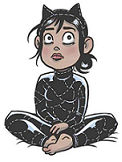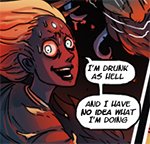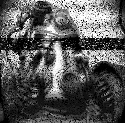|
Time for a rant on ancestor veneration! (Though I see you Bilirubin, if you need to ask more or post about something don't hold back, we'll get back at you It's often thought that old norse heathens practiced 'ancestor worship', but we honestly don't have any historical or archeological proof that you picked up a specific dead person to venerate, family or not. Some folks claim the 'elves' discussed are in myth are your male ancestors. Álfar appear in a lot of different contexts in the source material, however it very rarely has anything to do with dead males. They more often appear as living beings themselves. The most commonly accepted idea is simply that "Álfar" might not have ever been systematically recognized as a specific type of being but that they were spirits/beings that were connected to or the Æsir...so lesser gods of a sort. Another plausible theory is that originally the Álfar were the types of gods we now call the Vanir. Which is why "Vanir" is such a young word and "Æsir and Álfar" appear so often in old poetic meters and they alliterate. Freyr is...after all an Álfr himself, and is often titled 'The light elf' or 'light lord'. Like other gods, his skin colour was probably kind of screwy and consisted of a magic glow rather than colour, though this like so many other things can be debated. Anyway, "Ancestor Veneration" is actually a term from historical academia, projected onto indigenous or historic people. It is not necessarily an objective reality from the Iron Age, and it is a loaded term with a lot of problems. From the evidence it can't really be said that anyone, even kings, worshiped or venerated their own ancestors. Of course, kings put a lot of stock in their line of descent, but that's really more a concept from the emerging feudalism at the end of the Viking age. Christian kings do this as well, and it's more a political science than connected to spirituality. See also inheritance, which was extremely important no matter if you're in prehistory, iron age or even early modern and modern times. Anyway, all this mucking about with lineage was made for public consumption, and only socially important to the rulers themselves - so interpreting this as 'ancestor worship', as many historians have tried, is kind of dead end IMHO. A better term to describe old norse practices would be "cults of the dead". I'd like to quote Josúa Rood's recent rant for the rest: quote:That is, within the cosmic landscape that the average person lived, from farmer to trader, to magic-specialist to King, there were spirits and beings seen and unseen of all kinds. There were doorways to other worlds (beneath the waves the sea is another world. A forest is a different world from the mountain. And perhaps some worlds went to other places where cosmic rules were very different). Mountains and cliffs and trees were impregnated with meaning and legends and stories and taboos. Gods, wights, valkyrjar disir, dvergar, alvar, risir, thursar, BEARS, WOLVES, RAVENS, dead bodies, and everything else were part of countless complex connections. When people died, countless things could happen to them (which were not systematically organized and varied from place to place). They could go to an afterlife, like what we see with the burial on the volga river with the king going to a "paradise", and with king Hákon the good going to Valhall....whether he likes it or not. Or they could go back and forth between worlds, as we see with Helgi Hundingsbane going to and from Valhall and his mound, or stay in or around their mounds, like we see in numerous sagas. So, the 'ancestor veneration' must have been a more direct connection to the land and it's spirits - both those of nature, and of people who had shuffled the mortal coil. Either way it was a kind of interaction based on common needs, not a high familial bond.
|
|
|
|

|
| # ? Apr 16, 2024 17:16 |
|
I have a wee bit of writing vacation before my exam, so let's examine Hervararkvitra. It's the shorter of the two stories I haven't gotten to yet, and I'd like to wrap it up in time for Bjarkamål / Skuld, 'cause that one's even more insane HERVARARKVITRA the Lay of Hervor pt 1, or How Hervor became such a badass shield-maiden that would eventualy wrestle an artifact sword from her dead dad and curse her line forever Now, to understand why Hervor would go on to kick so much rear end, we have to consider that her father was dread Angantýr, a probably mythical ruler, whom we are told was "the tallest of the twelve sons of the berserker Arngrim", and he and his eleven brothers spread fear and destruction through the North. With Arngrim and Angantýr begins the story of the terrible magic blade Tyrfing, which cut through anything as if through cloth, and which killed a man every time it was unsheathed. Angantýr would eventually bite it against the warrior Orvar-Odd, and it went down like this: Hervor's Lay posted:The twelve brothers departed for Uppsala and Hjorvard proposed to Ingeborg. However then Hjalmar, one of the Swedish king's champions, stepped forth and claimed he deserved the princess rather than a berserker. Bad rear end. Her mother’s father was Jarl Bjartmar, another renowned rear end-whooper about whom we unfortunately don’t know much. Of course, this parentage meant that Hervor was going to be anything but a timid goodwife, and the frightened village she was born to all suggested that the best thing to do was to leave the baby exposed to be eaten by wild dogs. This didn’t happen, and she rather quickly started training horsemanship, weapons, archery and beating the crap out of the neighbourhood boys. Even as a youth she was massive, with a strong sword arm, stout back and long reddish-blond hair. She eventually became a shield-maiden, raiding and pillaging nearby islands under the male surname Hjørvard. She was by all accounts very adept at it, and when the leader of her raider band was killed in battle, the other vikings unanimously decided to name her war chief. This went on some time, before she learned (somewhere, the saga doesn’t state) that she is the daughter of Angantýr. This shouldn’t normally mean a lot, but Hervor immediately makes the decision to live like her father as a berserker, and furthermore, to gain possession of his cursed sword, Tyrfing, because if something is worth doing, it’s worth doing fully. Tune in next time, where Hervor shits on an entire island of powerful undead warriors because she’s bad at taking no for an answer!
|
|
|
Tias posted:
Sometimes the norse buried their dead under their house (archaeologists have found remains of infants in hearths and postholes), which may suggest some sort of death cult. But there's also stories from the sagas about people haunting their previous homes because they were buried there. Hrapp for example asked to be buried standing by the front door. But they had to move his body when Hrapp started haunting the place.
|
|
|
|
|
Maybe it's a prank. Bury a dude under your neighbor's house so he gets haunted, that sort of thing.
|
|
|
|
To be honest, the archeological evidence is our best basis for guesswork, since the sagas were strongly modified for their reader base, and many were written post-christianization. Most of the in-home burials were either at the insistence of quarrel-some men who are already destined to become draugr, or to try to appease one such hooligan from haunting the place. It's moralist fairy tales, essentially. I'll dig up my Neil Price, and see if I can find anything about in-house burials!
|
|
|
|
Tias posted:Odin is definitely omnipotent. Not sure where you'd get that claim from. Tias, followup seems better suited for this thread. I was taking that claim from the fact that Odin was unable to prevent Ragnarok; am I misinterpreting Ragnarok as something that Odin did not try to avoid?
|
|
|
|
Thanks, and yes, I agree it should be moved here  It's a tough question, as you probably know we don't have any reliable historical sources for norse heathenry and the stories of the gods. The eddas are problematic for the sole reason that they were translated by a machiavellian christian power player, who clearly attempted to change them for his own ends. The other gods clearly believe they have some agency, as when Loki's children is prophecied to start Ragnarok, they attempt to get rid of them. Odin doesn't partake, probably because he knows he can't stop it (but this, too, is mostly conjecture). I guess I misspoke, for writing it again I see clearly that a deity cannot be omnipotent if there is one thing it cannot do. However, Odin is largely all-mighty, he has power over death, life, war and the fates of civilizations - Ragnarok is just one of those things, like the power of gods, that is sort of woven into the cosmos, and even Odin can't tamper with the source code, so to speak.
|
|
|
|
I always presumed (in the traditional view) Odin was as bound by fate as the rest of us. I guess I'm transplanting Greek ideas about fate though, are they significantly different?
|
|
|
|
Tias posted:I guess I misspoke, for writing it again I see clearly that a deity cannot be omnipotent if there is one thing it cannot do. However, Odin is largely all-mighty, he has power over death, life, war and the fates of civilizations - Ragnarok is just one of those things, like the power of gods, that is sort of woven into the cosmos, and even Odin can't tamper with the source code, so to speak. Got it; thank you.
|
|
|
|
I'm curious, are there any heathens who use the Gesta Danorum as a source? If yes, how is it interpreted when it conflicts with the Eddas etc.? I'm thinking stuff like Hother killing Balder on purpose with the sword Mistletoe, as opposed to the Edda version.
|
|
|
|
Few heathens, especially outside of a northern european milieu, have even heard of GD, so my educated guess would be no.
|
|
|
|
The more heavily euhemerized versions are interesting, but are a better example of how religious/temporal outsiders looked at the myths than how believers looked at the myths. Sometimes they'll have details that didn't make it into the Poetic Edda manuscripts we have, but usually aren't see as authoritative in the same way. Snorri's Prose Edda should be looked at the same way, imo, but isn't because he does a better job of pretending to be an insider rather than being separated by hundreds of years from the belief in these stories. Also I'll never get over the way that he reconciled some poems saying there's an eagle on top of Yggdrasil, and some poems saying there's a hawk. The real reason there are differences is because different words were used to fit into different stanzas, but Snorri said "oh no, I know what's going on here. There's a hawk ON TOP of an eagle, on top of Yggdrasil."
|
|
|
|
Yeah, as a Dane I find it all sorts of interesting, I mean, sure a lot of the stuff is clearly mythic, but it does tie in with actual stuff in a lot of places. I'll admit to not being very interested in Snorri, nor wanting to be, but my response to that sort of thing is that he must just have been chuffed at the thought that pre-christian stuff is weird for the sake of weird, and painting it like that to score points with his contemporaries. He was by all accounts skilled in reading and making skaldic poetry, so either he understood what was actually going on or could have just admitted that there wasn't an exact rendition.
|
|
|
|
I'd like to hear more about the horsedick worship. Apart from the vølse story from the sagas, which I first heard referenced in a children's book (Erik Menneskesøn, lol), how much evidence is there in literature for it?
|
|
|
|
It's only found in Óláfs saga helga from Flateyjarbók, which I assume is the saga you refer to! However, it is largely thought to carry a grain of truth, as archeological finds indicate horse sacrifice was an integral part of pre-heathen cults.
|
|
|
Tias posted:It's only found in Óláfs saga helga from Flateyjarbók, which I assume is the saga you refer to! However, it is largely thought to carry a grain of truth, as archeological finds indicate horse sacrifice was an integral part of pre-heathen cults. this gets to the question of to what degree the early Christian histories of ritual sacrifice at the Temple of Uppsala was filtered through
|
|
|
|
|
Nine of each (it's always nine with us!) - and yeah, Adam's chronicle is theorycrafting of the most lurid sort. The archeological record doesn't even show good evidence there was a temple. While there was a bronze age building below the cathedral, it looks more like a feasting hall.
|
|
|
Tias posted:Nine of each (it's always nine with us!) - and yeah, Adam's chronicle is theorycrafting of the most lurid sort. Seven, nine, ugh, whatever. At 700-900 lbs each horse it would need to be a mighty tree indeed! Its neat that they found runestones in the cathedral and have now planted them in the churchyard, but apparently they are all new runes from Christian era. Still, pretty cool!  Out at Gamla Uppsala they still do midsommar fires at the barrows, which is cool. I had hoped I would have some sort of mystical revelation as to the location of the old temple and well and tree but lol of course not. (A propos of nothing, I just learned of and am listing to Heilung, very cool stuff)
|
|
|
|
|
Ah, Heilung! I have a hard time getting if they're actually heathen, or a weird stone-to-iron-age faith mishmash. Still, very interesting music. If this is your jam, make sure to check out Wardruna and everything else Einar Selvik has done, as well as the skaldic traditions they draw on.
|
|
|
Tias posted:Ah, Heilung! I have a hard time getting if they're actually heathen, or a weird stone-to-iron-age faith mishmash. Still, very interesting music. If this is your jam, make sure to check out Wardruna and everything else Einar Selvik has done, as well as the skaldic traditions they draw on. will definitely do. The music is pretty death metal without guitars and moody and haunting. The stage show is however very Vikings so whatever. Not something I am taking seriously other than be absorbed by the mood they create, its neat.
|
|
|
|
|
Finally got around to: HERVARARKVITRA pt ii, pissing off the undead for fun and (cursed) profit On to Tyrfing! Svafrlami, thought to be Odins grandson, captured the two dwarves Dvalinn and Durinn when they had left the rock where they dwelt. Then he forced them to forge a sword with a golden hilt that would never miss a stroke, would never rust and would cut through stone and iron as easily as through clothes. Pretty good, right? They made the blade, and it 'shone like fire'. However, they didn't like Svafrlami one bit for loving with their rock holiday, and they cursed it real hard: To kill a man every time it was unsheathed, and that it would be the cause of "three great evils". Finally, they made sure that it would kill Svafrlami, because of course they did. When Svafrlami learned about the curses (I imagine the dwarves shouting it at him, for some reason), he tried to kill Dvalinn, who at this point phased into a rock, where it got stuck, missing the dwarf. At this point Angantyr, Hervor's dad, shows up with his 11 brothers and kills him, taking the blade for themselves. Angantyr and his bros, in turn, were slain by the Swedish champion Hjalmar and his Norwegian sworn-brother Orvar-Odd. At this point, though, Hjalmar is wounded in the struggle by Tyrfing (it's first evil deed), and only has time to sing his death-song before asking Orvar-Odd to carry him to his wife's place to die, and Tyrfing is buried with Angantyr instead. Fast forward to Hervor wanting to own Tyrfing. According to one of her sagas, Hervor was brought up as a bond-servant, ignorant of her true parentage, and when she learns, she knows that Tyrfing is her heritage. She arms herself 'as a shieldmaiden', and while everyone tells her sword has been buried because it's really cursed and should never be used again, she is more interested in the fact that even the slightest nick from the blade will kill the recipient, and tells all the nay-sayers to gently caress off, gathering her crew for the expedition to Munarvoe, the burial place on the island of Samsø in Denmark. They arrive in the dead of night, and this is where stuff starts getting weird. Huge bonfires are burning in land, and apparitions of men fly through the air. This is enough to make her sensible crew refuse to go aboard, and she leaves board alone, cussing them out for their cowardice. She strides up to the burial mound, and then starts yelling insults at the dead berserkers, because why not speed things up a bit  "Hervararkvitra posted:"My your ribs writhe with worms, may your barrow be an anthill where you rot, unless you speak with me, sons of Arngrim, all girt with battle-gear, keen blades at your sides and bright spears stained with blood. Death has made you cowards, but I have kin-right here. I come for the sword made by Dvalin. Why should dead hands hold the blade?" This pisses off dad, who throws up a huge wall of fire around his tomb - but Hervor just leaps through it, reitering that she isn't loving leaving without Tyrfing. The nerve! Angantyr explains that this isn't a super good idea, to which Hervor softens a bit, saying the gods will bless him if he gives up the sword. This doesn't fly, and Angantyr materializes along with all his brothers and hirdmen, 12 feet tall in full armour and with rotting eyes. Angantyr prophecizes a bit, telling her just how bad of an idea it is: quote:Hear me, Hervor, hear from me now, Hervor, pissed, calls him a coward and to give it up, and reiterates that the sword is no good to dead men. Angantyr, presumably a bit impressed with his girl at this point, reveals his corpse and the location of the blade underneath, though wrapped in another wall of fire and 12 ghosts who hate her. He explains that no mortal woman can carry the blade, so she might well give it up. Hervor explains that she doesn't give two fucks about him or the curse, and declares that she'll take it and carry it through the flames. Finally impressed, Angantyr says he can't refuse such courage of heart, and she walks through the second wall of fire and ghosts, and takes Tyrfing. Walking to the shore, she discovers that her vikings have left her in panic, and found a way off the island (the sources aren't specific as to how), got back to her homeland, and continued her career as a war-band leader. To couch it in nerd terms, Tyrfing increased her power level by 9000 and became the terror of all of Scandinavia, Europe and England, and chopped heads with it all over the place. It also kind of made her mad, which goes with the territory - At one point she plays dice with the king of Norway, and some idiot starts playing around with the sword, so Hervor flips and kills him right there in the throne room. I imagine everyone clapped, because vikings can appreciate that sort of thing. Eventually, she settled down, got married, and had a couple kids. Her son Heidrik inherited Tyrfing, and its cursed effects seemed to affect him a lot more than his mom. He ended up murdering his brother and his foster son with it, and eventually died in battle surrounded by a bunch of dead Huns (Heidrik's own daughter, who was named Hervor after her grandma, also fought as a shieldmaiden in the battle and was killed in action). Heidrik married a princess, though, so his life wasn't all poo poo. We don't really know what happened to Hervor after her son inherited Tyrfing. Some say she died in combat while fighting in a war of vengeance, and others claim she just grew old and died a peaceful, boring death at home. A later saga briefly mentions a mysterious Valkyrie named Hervor, so it's presumably also possible that the pure spite of this warleader helped her ascend to goddesshood, which would, of course, be awesome. Bilirubin posted:will definitely do. The music is pretty death metal without guitars and moody and haunting. The stage show is however very Vikings so whatever. Not something I am taking seriously other than be absorbed by the mood they create, its neat. Eh, I'd argue with you, but truthfully it probably isn't really designed for consumption outside the heathen folk/metal milieu. For what it's worth, at least Kai Uwe from Heilung is an accredited shaman, and fully believes in the stuff he does, which is probably why it resonates with so many heathens and other neo-primitives. If you like death metal without guitars, consider the stuff Selvik did with Enslaved frontman Ivar Bjørnson (in celebration of the 200 year anniversary of the Norwegian constitution
|
|
|
|
A little busy, but I'd like to offer some of the latest discussion in heathen circles. Both in my heathen men's group and left-wing groups at least, people have finally started to problematize the anti-christian sentiment. It's not that we don't think the christians of 1000-1200 suck for murdering all the original heathens, we do, but today two things seem to be clicking for modern heathens: 1) Modern religion shouldn't harass religion. By hating christians we're essentially lowering ourselves to the fundies' level - and as polytheists we have no real business making GBS threads on other gods. 2) Being anti-christian is actually a full-circle transformation into the stupid, brutely pagan stereotypes the christians of old set up themselves. Quoth Rune Hjarnø, norse and animist religion phd and all-around cool dude: Rune Hjarnø posted:1) It prevents the development of knowledge and thinking with weirdly anti-dogmatic dogma, that impedes thinking and dialogue, because positions can not really be assumed, tested against each other and developed. Someone will often close down the process of thought with some relativist dogma about agreeing to disagree. (this is an extremely prominent feature of DK heathens)
|
|
|
|
I'm all for hating on fundamentalists of any color, those people are harmful to other people, often directly and to society in general. But hating on all religious people on principle, just because they're religious? That's some powerful bigotry, and I'm glad people are calling it out. Richard "Dick Dorkins" Dawkins-style performative religion-bashing fundamentalist atheism is something I just can't get behind, but I have friends who are big fans of his. I just don't get it, why spend so much energy hating on something? While I consider myself atheist*, I've been avoiding using the term because I don't want to be associated with militant capital-A fedora Atheists. *I'm all for spiritual-style communing with nature and such, personally I see it more as empathy and connection with life and the natural world than something otherworldly. KozmoNaut fucked around with this message at 11:25 on Mar 12, 2021 |
|
|
|
KozmoNaut posted:Richard "Dick Dorkins" Dawkins-style performative religion-bashing fundamentalist atheism is something I just can't get behind, but I have friends who are big fans of his. I just don't get it, why spend so much energy hating on something? There are a lot of people who have deep scars from currently presented Western Christianity (my experience has mostly been with ex-Southern Baptists and ex-Catholics in the SE US, to contextualize), for a sliding scale of reasons from very bad to very good. For some of those people, anyone delivering any blow to currently presented Western Christianity is someone to celebrate. To go back to the original Tias post: 1. I agree that modern people should not harass modern people for their religion. 2. I am 100% unsurprised that the people who rejected Western Christianity to revive - and recreate, and recontextualize (as noted in Tias's thread OP) - Norse heathenry, have somewhat hostile views generally towards said Western Christianity.
|
|
|
|
I mean, we do. It's really hard to put behind you, culturally speaking. Even the modern and inclusive Troth used to talk about how christians killed by pagans got 'what was coming to them', and while kinda understandable it's locking ourselves in anti-modern patterns of thought - and so we should try to break free and discuss what a new modern heathenry could look like.
|
|
|
Tias posted:A little busy, but I'd like to offer some of the latest discussion in heathen circles. Do they know what the heathens did to the christians around the same time?
|
|
|
|
|
A little of a (know, but don't care), b (don't know and won't find interest) and c (know, cares but relativizes it as unavoidable in the anti-modern setting).
|
|
|
|
Is it wrong when the colonised fight back against the coloniser? If Colombus had landed and then gotten an arrow through the eye, would we be lamenting his tragic fate? The above thing that Tias posted has some good points in it, but the fact that Charlemagne, a man who attempted ethnic cleansing, is the person gone to as a representative of "Christendom" is both hilarious and pretty drat dark at the same time.
|
|
|
|
The point of the post isn't that heathens look bad in comparison to Charlemagne, but that modern heathens obssession with reconstructing the past make them fulfill the stereotypes that Charlemagne (who was terrible) painted of them.
|
|
|
|
Tias posted:The point of the post isn't that heathens look bad in comparison to Charlemagne, but that modern heathens obssession with reconstructing the past make them fulfill the stereotypes that Charlemagne (who was terrible) painted of them. I think that if you apply those ideals as widely as they are in that particular instance you can argue that virtually any belief system fulfils the stereotypes that ole Charlie is putting out. Not least the definition of "civilization" as something which requires an inherent hierarchy. If I am kramering into this thread and should shut up let me know, but I wanted to disagree with some of what the article is laying out. Also sorry for any spelling mistakes. I am on phone atm and it's hard to use. Thank you.
|
|
|
|
No no we're cool man, any content that isn't trolling is welcome. Well, I think he's being rather specific. The fact that modern heathens are opposed to organization, too obsessed with the proper method of reconstruction to ever actually create modern theology, and embrace stereotypical viking images are all pretty spot on, and specific to heathenry, as well as certain other new age and reconstructionist movements.
|
|
|
|
Tias posted:No no we're cool man, any content that isn't trolling is welcome. Got it, but do let me know if I am being impolite. I don't like upsetting folks. Should they want to create a modern theology? Most attempts at such usually fall flat because of a lack of miracles and a lack of direct connection to people. Striving for an imagined past and reinterpreting the present through that lens seems to be a continual goal of all theological work. Being opposed to organisation is not an inherently bad concept, not least because a great deal of creating structures leads to the creation of out groups and doctrinal wrangling. Alongside that I find that we can't really talk of how "ridiculous" heathenry looks as a faith without pointing to various different priesthood and raising an eyebrow at least.
|
|
|
|
I'm pretty sure the answer is going to be "because racists are stupid and don't read" (which is a perfectly fine answer), but how do the nazi types justify or rationalize the sheer amount of "interbreeding" and "race mixing" between the Aesir and the Jotuns? I could see it if, like, it was just an "evil" Áss like Loki who was part Jotun, but Odin's grandmother was one as well, and Thor, as a result, is mostly Jotun... And these aren't, like, minor references in some obscure work of dubious precedent no one has translated. The poetic edda is pretty blatant about it, and the prose edda has them all being Trojan? I mean, pretty obviously racism is dumb and makes very little sense, but what knots do they tie themselves in to explain how, no, seriously, Thor definitely hates Jewish people?
|
|
|
|
Toph Bei Fong posted:I'm pretty sure the answer is going to be "because racists are stupid and don't read" (which is a perfectly fine answer), but how do the nazi types justify or rationalize the sheer amount of "interbreeding" and "race mixing" between the Aesir and the Jotuns? Odin's mother is actually a jotunn, the giantess Bestla. Well, the short of the long is, either they don't reason at all, or they decide it doesn't count because both jotunn and aesir are races of gods, and so don't create precedent for what humans should do (and also all white people descend from Odin because reasons).
|
|
|
|
Tias posted:Well, the short of the long is, either they don't reason at all, or they decide it doesn't count because both jotunn and aesir are races of gods, and so don't create precedent for what humans should do (and also all white people descend from Odin because reasons). I thought that the Eddas had everyone descended from trees and various different other things. What kind of cosmology are the awful fascists using?
|
|
|
|
If you're going by the Prose Edda Thor is half African. He's son of Mennon, an Ethiopian king, and a Trojan princess.quote:These chieftains were in every manly part greatly above other men that have ever been in the world. One king among them was called Múnón or Mennón; and he was wedded to the daughter of the High King Priam, her who was called Tróán; they had a child named Trór, whom we call Thor. Prologue III, here.
|
|
|
|
Cessna posted:If you're going by the Prose Edda Thor is half African. He's son of Mennon, an Ethiopian king, and a Trojan princess. Yep. Of course, Mennon was also King of Persia and India, so... Also, while not a heathen myself, I doubt many would agree with the explicitly Christian origin story of the gods in the beginning of the Prose Edda.
|
|
|
|
Epicurius posted:Also, while not a heathen myself, I doubt many would agree with the explicitly Christian origin story of the gods in the beginning of the Prose Edda. No, of course - I seriously doubt, for example, that anyone would go along with the origins presented by Sturluson (the gods are all Trojans). My point here is that the Eddas are not, to my understanding, seen as infallible holy writ, where not a single word can be ignored. They're open to interpretation; some parts are more valid than others. If you can ignore the parts that clearly say Thor was Ethiopian and Trojan, you can ignore other things as well. The unfortunate drawback of this is that racist assholes, if they put any thought into it, thereby ignore anything that doesn't go along with their warped world view, up to the point of deliberately rejecting all of the parts that clearly and directly show that the gods weren't racists.
|
|
|
|
There’s an extremely important distinction to be made between the Poetic and Prose Eddas. The Prose Edda was written by Snorri (probably), about 200 years after his country (Iceland) had officially converted to Christianity. The Prose makes an attempt to reconcile a lot of conflicting sources into a single authoritative text, and was written by a Christian. My favorite example of the weird choices made trying to reconcile conflicts is the author’s decision that because some poems refer to an eagle on top of Yggdrasil, and others refer to a hawk, that must mean that there is a hawk sitting on top of an eagle sitting on top of Yggdrasil. The Prose Edda does quote some of the poems we still have, as well as referencing poems we don’t have or only have parts of. It’s also an Icelander’s take on things, and we know because of some archaeological evidence as well as toponyms that Norway and Iceland seem to have focused more on the Aesir than Denmark and Sweden did. The Poetic Edda is the name given to the collection of poems found in what’s called the “codex reggius” a single handwritten book that compiled many different poems. It was written in the Christian Era of Iceland as well, but theres no reason to think Snorri was involved in this one. Linguistic analysis shows that some of the poems were hundreds of years old by the time they were written (due to the choice of words that used to fit into the meter but had shifted to no longer fit at the time they were written down, etc). This is definitely a much more authentic source of knowledge, but is only a portion of the poems common to the time and obviously poems leave a lot more to interpretation than prose does. It’s also Icelandic so it has the possibility of not accurately reflecting the beliefs and stories told by eastern Scandinavians.
|
|
|
|

|
| # ? Apr 16, 2024 17:16 |
|
Thanks to this thread I was able to recognize some douchebag for what they probably are on the freeway. Their red sports car had a huge eagle decal on the front window and a giant decal of The Vegvisr on the back. I was able to glare at this probable rear end in a top hat as he sped by and imagine myself keying that fancy car. I could be wrong and it was a well-meaning practicing Heathen, but this was an extremely white dudebro looking person in the driver's seat, so I doubt it.
|
|
|































